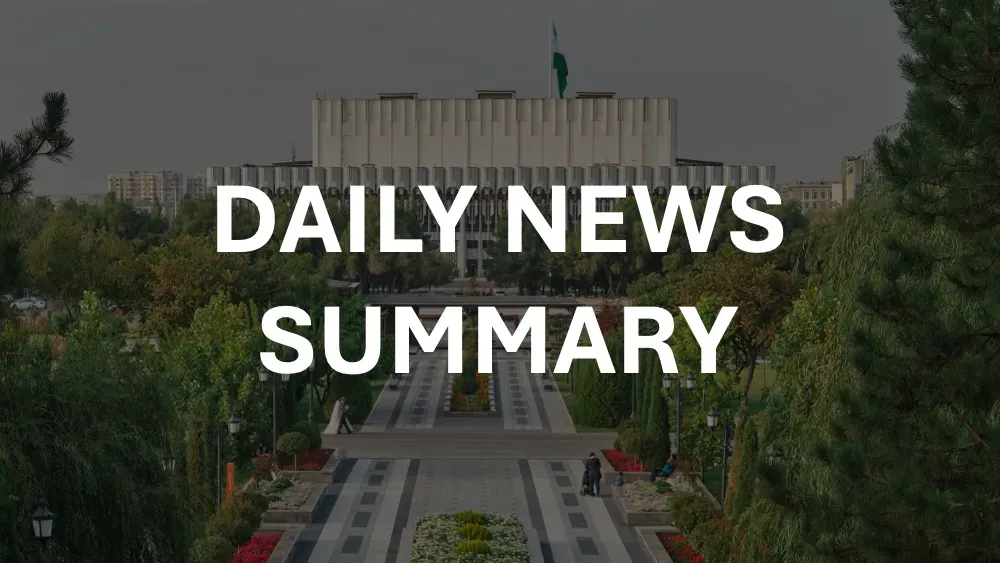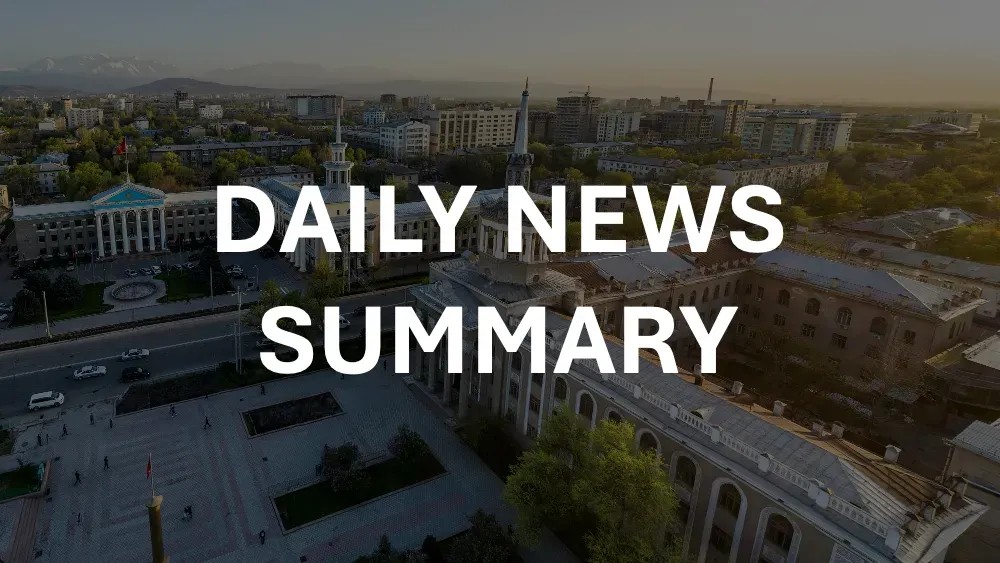📍 Get daily intelligence from Kyrgyzstan and Central Asia. Lexica News delivers local news that shapes global decisions—synthesized from local sources international media misses.
The nationalization of the Kumtor gold mine in May 2021 represents one of Central Asia's most significant acts of resource nationalism, transforming Kyrgyzstan's largest foreign investment into a cautionary tale worth $3.1 billion in penalties and legal disputes. The seizure of Canada's Centerra Gold operations demonstrates how governments can effectively override international investment agreements through domestic legislation, environmental claims, and political mobilization, despite formal arbitration protections.
The Kumtor mine, responsible for 12% of Kyrgyzstan's GDP and nearly one-third of budget revenues, became a lightning rod for nationalist sentiment after decades of foreign control over the country's most valuable asset. President Sadyr Japarov's rise to power in January 2021 accelerated the nationalization process, fulfilling campaign promises that resonated with voters frustrated by foreign extraction of domestic resources.
This analysis documents the mechanisms, costs, and consequences of the Kumtor nationalization, examining how Kyrgyzstan achieved state control through environmental penalties, legislative changes, and strategic arbitration management. The case reveals patterns in resource nationalism that international investors encounter across developing economies where natural resources represent both economic opportunity and political vulnerability.
Current Landscape: From Foreign Investment to State Control
The Kumtor gold mine produced over 13.2 million ounces of gold between 1997 and 2020 under Centerra Gold's management, making it the largest private-sector employer and taxpayer in the Kyrgyz Republic. The mine's contribution to national finances reached unprecedented levels, with gold accounting for almost 39% of the country's exports in 2023, valued at approximately $1.3 billion.
Before nationalization, the operation generated substantial returns for both parties. Centerra's 2020 annual report showed Kumtor produced 556,000 ounces of gold that year, contributing 12.5% of Kyrgyz GDP. The company had invested heavily in infrastructure and community development programs, positioning itself as a responsible foreign investor committed to long-term operations.
The political landscape shifted dramatically with Japarov's ascension to power. His political career included arrests related to Kumtor protests, including participation in the October 2012 storming of Bishkek's White House advocating for mine nationalization. RFE/RL documented how Japarov's nationalist rhetoric positioned foreign control of Kumtor as economic colonialism, resonating with public sentiment that viewed gold exports as wealth extraction without commensurate national benefit.
Environmental concerns provided the legal foundation for government intervention. The mine's location above glacier systems created ongoing disputes about waste rock placement and environmental impact. OpenDemocracy reported that environmental groups had documented concerns about glacier damage, though the extent of impact remained contested between company environmental assessments and government claims.
The economic context in 2021 supported nationalization arguments. Despite decades of gold production, Kyrgyzstan remained among the region's poorest countries, with limited economic diversification beyond mining and agriculture. Public discourse increasingly questioned whether foreign-controlled mining truly benefited national development or merely extracted resources while leaving environmental and social costs.
Documented Experiences: The Mechanics of Nationalization
The nationalization process unfolded through coordinated legal, legislative, and administrative actions beginning in early 2021. Al Jazeera documented that lawmakers in May 2021 passed legislation allowing state seizure of Kumtor for up to three months, arguing the mine posed dangers to locals and the environment.
A Bishkek district court simultaneously imposed a $3.1 billion fine on Kumtor Gold Company for breaching environmental laws by placing waste rock on glaciers. The court ruling exceeded the mine's total historical profits, effectively creating an impossible financial burden that justified government intervention. Additional claims included over $170 million in allegedly unpaid taxes, creating multiple pressure points for seizure justification.
Interfax reported that the government appointed Tengiz Bolturuk, a former Centerra Gold board member, to manage operations during the transition. This appointment demonstrated government preparation for operational continuity while asserting national control. The choice of someone familiar with the mine's operations suggested strategic planning rather than impulsive seizure.
Centerra Gold responded through multiple legal channels. The Globe and Mail documented that the company initiated UNCITRAL arbitration proceedings, filed for bankruptcy protection in New York for its Kyrgyz subsidiaries, and pursued asset recovery through Canadian courts. This multi-jurisdictional approach reflected the complexity of challenging state seizure under investment protection frameworks.
The transition period revealed operational realities under state management. Mining.com reported that the mine produced 513,624 ounces of gold in 2021, exceeding Centerra's guidance of 470,000-510,000 ounces. In the final seven months under full government control, operations generated $323 million in profits, demonstrating the mine's continued viability under state management.
Production metrics showed mixed results under nationalization. bne IntelliNews documented declining output trends, with production falling from 17.3 tonnes in 2022 to 13.5 tonnes in 2023, and 12.5 tonnes in 2024. These figures reflected technical challenges as the mine transitioned from open-pit to underground operations, requiring new equipment and expertise.
The financial settlement reached in April 2022 provided closure while avoiding prolonged arbitration. The Diplomat reported that state-owned Kyrgyzaltyn gained full mine ownership in exchange for ceding its 26% stake in Centerra Gold, plus a $50 million cash payment. This agreement represented swift resolution compared to typical investor-state disputes, which often extend for years without guaranteed recovery.
Stakeholder Realities: Winners, Losers, and Unintended Consequences
Government officials presented nationalization as economic justice, with President Japarov projecting at least $5 billion in profits over the following decade under state control. The mine's contribution to government revenues increased substantially, with official reports showing gold exports valued at approximately $1.3 billion in 2023, representing nearly 39% of national exports.
Fiscal performance supported government claims of improved national benefit. World Bank data shows Kyrgyzstan recorded fiscal surpluses of 1.8% of GDP in 2024, driven by stronger tax and non-tax revenues including increased mining contributions. Public debt fell from 42% of GDP in 2023 to 37.5% in 2024, partially reflecting improved resource revenues under state control.
International investors viewed the nationalization as a warning signal for regional investment. US State Department investment climate statements noted that foreign direct investment decreased by 24% between 2022 and 2023 to less than $800 million, citing the Kumtor case among factors deterring investment. The nationalization reinforced perceptions of weak property rights protection despite formal investment agreements.
Environmental groups achieved mixed outcomes from the nationalization process. While the seizure addressed concerns about glacier damage, The Diplomat documented that underground mining operations commenced in August 2024, potentially creating new environmental challenges. The transition to underground extraction addressed surface glacier concerns but introduced underground water and stability risks.
Local communities experienced varied impacts from the ownership change. The mine remained the region's largest employer, with operational continuity maintained through the transition period. However, international development programs and community investment initiatives that Centerra had maintained faced uncertainty under state management, as government priorities focused on revenue maximization rather than corporate social responsibility frameworks.
Regional mining companies adjusted strategies in response to the precedent. Global Arbitration Review documented that three Central Asian republics have faced mining-related investment arbitration claims, with the Kumtor case demonstrating that even established mining operations with long-term agreements remain vulnerable to political change and resource nationalism.
Canadian-Kyrgyz relations experienced diplomatic strain despite the eventual settlement. While formal diplomatic ties continued, the nationalization created lasting concerns about investment security that extended beyond mining to other sectors. The Caspian Policy Center noted that resolution required intensive diplomatic engagement to prevent broader bilateral relationship deterioration.
Understand Kyrgyzstan Like an Insider
This analysis draws from extensive research, but the story continues to evolve daily. Lexica synthesizes breaking developments from dozens of Kyrgyz news sources—from mining policy changes to local protests that never make international headlines.
Our daily intelligence briefs help executives, diplomats, and researchers track:
- Regulatory shifts affecting foreign investment
- Local opposition to development projects before they escalate
- Market dynamics that signal opportunity or risk
- Political developments that reshape the business landscape
Operational Context: The Technical and Financial Realities
Underground mining development represents the most significant operational challenge following nationalization. Times of Central Asia reported that underground operations officially began in August 2024, with geological reserves of 147 tonnes of gold on the state balance sheet. The transition required substantial technical expertise and capital investment that the government committed to despite limited experience in underground mining management.
Production costs increased substantially under the new extraction methods. While specific figures remained confidential, Mugglehead Investment Magazine noted that shaft mining costs significantly exceed open-pit methods. However, gold prices above $2,000 per ounce made underground operations economically viable, with higher-grade ore potentially offsetting increased extraction costs.
Technical challenges included transitioning from equipment optimized for open-pit operations to underground mining systems. The government retained some former Centerra technical staff while recruiting additional expertise, creating hybrid management combining local knowledge with international mining experience. This approach aimed to maintain operational continuity while building national technical capacity.
Environmental compliance evolved under state management, with the government implementing new monitoring systems for underground operations. The underground project addresses surface glacier concerns that provided justification for nationalization, though long-term environmental impact assessment continues as operations expand into previously unmined areas.
Financial performance under state control showed mixed results reflecting the operational transition period. Revenue increased due to higher gold prices and improved ore grades from underground mining, but operational costs also rose due to new extraction methods and technical learning curves. State reports showed net profits of $302.4 million in 2023, exceeding planned targets of $194 million.
Capital expenditure requirements for underground expansion created funding challenges for the government. Unlike private mining companies with access to international capital markets, state-owned operations relied on government budgets and potential future revenue sharing agreements. This financing constraint limited expansion pace compared to private operators with established financing relationships.
Labor relations stabilized under state management, with employment levels maintained throughout the transition period. The government committed to preserving jobs while transitioning technical roles from foreign to local management. Training programs for underground mining techniques became priorities as operations expanded below ground level.
Regional Comparison: Central Asian Resource Nationalism Patterns
Kazakhstan presents a contrasting approach to foreign mining investment management. World Bank mining sector diagnostics show Kazakhstan maintained foreign partnerships while asserting greater state participation through joint ventures and taxation rather than outright nationalization. The country's larger economy and diversified resource base provided more negotiating leverage without requiring seizure tactics.
Mongolia's mining sector demonstrates similar nationalist pressures but different outcomes. Academic research on Mongolia's resource nationalism shows "revolutionary" resource nationalism focused on political advantages rather than development-oriented economic nationalism. However, Mongolia maintained foreign partnerships in major projects like Oyu Tolgoi while renegotiating terms rather than pursuing nationalization.
Uzbekistan's mining approach emphasizes state control from the outset, avoiding the investment-nationalization cycle observed in Kyrgyzstan. Academic analysis of Central Asian mining risks ranks Uzbekistan's investment climate as challenging due to bureaucratic constraints, but the country avoids sudden policy reversals by maintaining consistent state-controlled approaches from initial investment phases.
The arbitration landscape across Central Asia reveals systemic challenges for foreign investors. Global Arbitration Review documented that three of five Central Asian republics have faced mining-related investment arbitration claims, primarily arising from government interference with mining rights, license revocations, or permit delays. Kyrgyzstan's direct seizure represents an extreme but increasingly common approach.
Investment protection frameworks show limited effectiveness against determined government action. Despite investment agreements and arbitration clauses, the Kumtor case demonstrates that states can achieve de facto control through environmental regulations, tax claims, and legislative changes that create conditions favoring negotiated exit rather than prolonged legal battles.
China's growing influence in regional mining creates additional complexity for Western investment. Carnegie Endowment analysis notes that Beijing controls most rare-earth mining leases in Kyrgyzstan and Tajikistan, providing alternative partnerships for governments seeking to reduce dependence on Western investment while maintaining mining sector development.
Conclusion: Lessons in Resource Nationalism and Investment Risk
The Kumtor gold mine nationalization demonstrates how determined governments can effectively override international investment protections through coordinated domestic legal action, environmental claims, and strategic political mobilization. Kyrgyzstan's success in gaining full mine control within 14 months, while avoiding prolonged arbitration costs, provides a template that other resource-dependent economies may emulate when political conditions favor state control over foreign-managed natural resources.
The financial outcomes validate government projections of improved national benefit from state ownership. Gold exports reached $1.3 billion in 2023, contributing to fiscal surpluses and reduced public debt. Underground mining operations launched in 2024 address environmental concerns while accessing higher-grade ore deposits projected to sustain production for 17 years. These operational successes demonstrate that nationalization can achieve both political and economic objectives when governments possess sufficient technical capacity and market conditions support continued operations.
However, the broader investment climate effects remain mixed. Foreign direct investment declined 24% following the nationalization, reflecting investor concerns about property rights protection despite formal investment agreements. The case illustrates the limitations of bilateral investment treaties and arbitration frameworks when governments utilize domestic legal systems, environmental regulations, and political pressure to achieve de facto control over valuable assets.
Regional patterns suggest the Kumtor case represents broader trends in Central Asian resource nationalism rather than an isolated incident. Three of five regional countries have faced mining-related investment disputes, indicating systemic challenges for foreign resource investment across post-Soviet economies where natural resources carry significant political symbolism and economic importance.
The technical transition to underground mining presents both opportunities and risks for sustained operations. While higher-grade ore deposits and improved environmental compliance support long-term viability, increased operational costs and technical complexity require sustained government investment and expertise development. The success of underground operations will determine whether nationalization delivers promised economic returns or creates operational challenges that reduce mine productivity.
Current gold prices above $2,000 per ounce provide favorable conditions for continued profitability under state management. However, commodity price volatility and operational uncertainties associated with underground mining create risks that private investors typically manage through diversified portfolios and international financing access. The government's ability to manage these risks through budget allocation and technical capacity building will determine long-term outcomes.
For international investors, the Kumtor case highlights the importance of political risk assessment that extends beyond formal legal protections to include domestic political dynamics, resource nationalism trends, and government fiscal pressures. Investment agreements and arbitration clauses provide limited protection against determined government action supported by domestic legal mechanisms and popular political support.
The case warrants monitoring as a potential template for resource nationalism in other developing economies where foreign-controlled mining operations generate significant export revenues while local populations perceive limited economic benefit. The speed and effectiveness of Kyrgyzstan's approach, combined with successful operational continuation under state management, may influence government calculations about the costs and benefits of resource nationalization in similar contexts.
Frequently Asked Questions
How did Kyrgyzstan legally justify seizing the Kumtor mine despite investment protection agreements?
The government used environmental law violations as the primary legal basis, with a Bishkek court imposing a $3.1 billion fine for placing waste rock on glaciers. Centerra Gold documented that lawmakers simultaneously passed legislation allowing state seizure when operations pose environmental or health dangers. Additional tax claims exceeding $170 million created multiple justifications that made challenging any single legal basis difficult through international arbitration.
What were the actual financial costs and benefits of nationalization for both parties?
Kyrgyzstan gained mine assets worth several billion dollars while assuming operational responsibilities and technical risks. The final settlement required the government to pay $50 million cash and cede Kyrgyzaltyn's 26% Centerra stake worth approximately $200 million. Centerra avoided prolonged arbitration costs and retained assets outside Kyrgyzstan. Government revenues increased substantially, with mining contributing nearly 39% of exports valued at $1.3 billion in 2023.
How has mine production and profitability changed under state management?
Production initially exceeded targets in 2021 but declined in subsequent years as operations transitioned to underground mining. Output fell from 17.3 tonnes in 2022 to 12.5 tonnes in 2024, reflecting technical challenges and equipment transitions. However, profitability remained strong due to higher gold prices and improved ore grades from underground extraction. State management reported $302.4 million in profits in 2023, exceeding planned targets of $194 million.
What risks does the Kumtor case create for foreign mining investment in Central Asia?
The nationalization demonstrated that established operations with long-term investment agreements remain vulnerable to political change and environmental claims. US State Department data shows foreign direct investment in Kyrgyzstan fell 24% between 2022 and 2023, partially reflecting investor concerns about property rights protection. Regional analysis indicates similar risks across Central Asian mining sectors, where three countries have faced mining-related arbitration claims primarily involving government interference.
How do underground mining operations compare to the previous open-pit methods at Kumtor?
Underground mining addresses environmental concerns about glacier damage while accessing higher-grade ore deposits. Technical analysis shows geological reserves of 147 tonnes available through underground methods, with the project expected to operate for 17 years. Costs increased substantially compared to open-pit extraction, but current gold prices above $2,000 per ounce make operations economically viable. The government projects that underground mining could double yields compared to open-pit methods.
What precedent does this case set for resource nationalism globally?
The Kumtor nationalization represents successful state seizure achieved through coordinated legal, environmental, and political action while avoiding prolonged arbitration. The swift resolution within 14 months contrasts with typical investor-state disputes lasting years without guaranteed recovery. International observers note the case demonstrates that determined governments can effectively override investment protections through domestic legal mechanisms, environmental claims, and strategic negotiation pressure.
How has the nationalization affected Kyrgyzstan's broader investment climate?
Beyond reduced foreign direct investment, the case created lasting concerns about contract sanctity and property rights protection. Investment assessments cite weak property rights protection, criminal investigations influencing commercial disputes, and frequent government turnover as ongoing deterrents to foreign investment. However, the government's successful mine management and improved fiscal performance demonstrate that nationalization can achieve stated economic objectives, potentially encouraging similar approaches in other resource-dependent economies.
Track Kyrgyzstan with Local Intelligence
The rare earth story exemplifies why local sources matter. While international media reports MOUs and ministerial visits, Uzbek outlets cover the community protests, water disputes, and regulatory changes that actually determine project outcomes.
Lexica delivers what you're missing:
- Daily briefs at 7AM Bishkek time covering 40 top stories from politics to economics
- Full-text synthesis from sources in Kyrgyz
- Searchable archive to track how today's announcements connect to yesterday's promises
- Multi-country coverage across Central Asia for regional context
Whether you're evaluating investment opportunities, monitoring supply chain risks, or analyzing geopolitical developments, local intelligence reveals what international headlines obscure.










